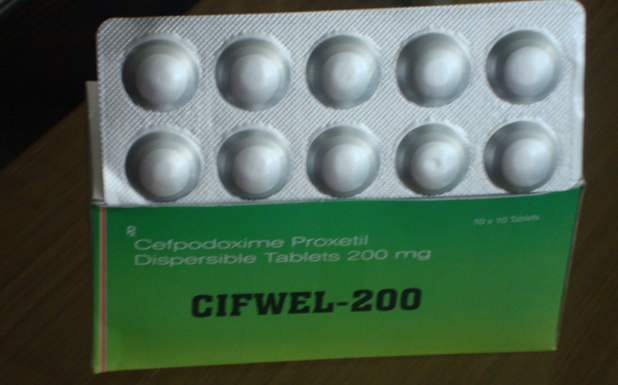Indications:
● Acute otitis media
● Pharyngitis and/or tonsillitis
● Community-acquired pneumonia
● Acute bacterial exacerbation of chronic bronchitis
● Acute, uncomplicated urethral and cervical gonorrhea
● Acute, uncomplicated ano-rectal infections in women
● Uncomplicated skin and skin structure infections
● Acute maxillary sinusitis
● Uncomplicated urinary tract infections (cystitis).
Pharmacology:
Advantages of using cefpodoxime over other cephalosporins:
Cefpodoxime is active against a wide spectrum of Gram-positive and Gram-negative bacteria. Cefpodoxime is stable in the presence of beta-lactamase enzymes. As a result, many organisms resistant to penicillins and cephalosporins, due to their production of beta-lactamase, may be susceptible to cefpodoxime.
Mechanism of Action:
The bactericidal activity of cefpodoxime results from its inhibition of cell wall synthesis. The active metabolite of cefpodoxime binds preferentially to penicillin binding protein 3, which inhibits production of peptidoglycan, the primary constituent of bacterial cell walls. Cefpodoxime proxetil is a prodrug that is absorbed from the gastrointestinal tract and de- esterified to its active metabolite, cefpodoxime.
Pharmacokinetics:
Absorption: Following oral administration of 100 mg of cefpodoxime proxetil to fasting subjects, approximately 50% of the administered cefpodoxime dose was absorbed systemically.
Protein binding: 22 to 33% in serum and from 21 to 29% in plasma.
Elimination: Over the recommended dosing range (100 to 400 mg), approximately 29 to 33% of the administered cefpodoxime dose was excreted unchanged in the urine in 12 hours.
Half life: 2.09 to 2.84 hours.
Adverse Effects:
● Upset stomach
● Diarrhea
● vomiting
● Mild skin rash.
Contraindications:
● Hypersensitivity reactions to cefpodoxime, other cephalosporins, penicillins, or other drugs.
● If cefpodoxime is to be administered to penicillin sensitive patients, caution should be exercised because cross hypersensitivity among beta-lactam antibiotics has been clearly documented and may occur in up to 10% of patients with a history of penicillin allergy.
Drug Interactions:
Antacids: Concomitant administration of high doses of antacids (sodium bicarbonate and aluminum hydroxide) or H2 blockers reduces peak plasma levels by 24% to 42% and the extent of absorption by 27% to 32%, respectively. The rate of absorption is not altered by these concomitant medications. Oral anti-cholinergics (e.g., propantheline) delay peak plasma levels (47% increase in Tmax), but do not affect the extent of absorption (AUC).
Probenecid: As with other beta-lactam antibiotics, renal excretion of cefpodoxime was inhibited by probenecid and resulted in an approximately 31% increase in AUC and 20% increase in peak cefpodoxime plasma levels.
Nephrotoxic drugs: Although nephrotoxicity has not been noted when cefpodoxime proxetil was given alone, close monitoring of renal function is advised when cefpodoxime proxetil is administered concomitantly with compounds of known nephrotoxic potential.
Drug/Laboratory Test Interactions: Cephalosporins, including cefpodoxime proxetil, are known to occasionally induce a positive direct Coombs' test.
Take cefpodoxime tablets with food.
Warning and Precautions:
Before taking cefpodoxime,
● Tell your doctor and pharmacist if you are allergic to cefpodoxime or any other cephalosporin antibiotic such as cefadroxil (Duricef) or cephalexin (Keflex), penicillin, or any other drugs.
● Tell your doctor and pharmacist what prescription and nonprescription medications you are taking, especially other antibiotics, anticoagulants ('blood thinners') such as warfarin (Coumadin), probenecid (Benemid), and vitamins.
● Tell your doctor if you have or have ever had kidney or liver disease, colitis, or stomach problems.
● Tell your doctor if you are pregnant, plan to become pregnant, or are breast-feeding. If you become pregnant while taking cefpodoxime, call your doctor.
●If you are having surgery, including dental surgery, tell the doctor or dentist that you are taking cefpodoxime.
